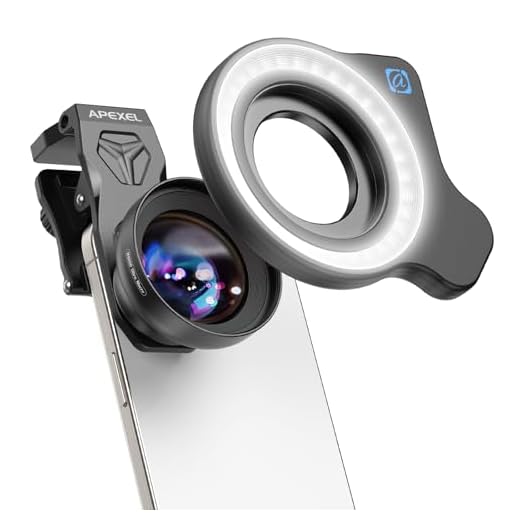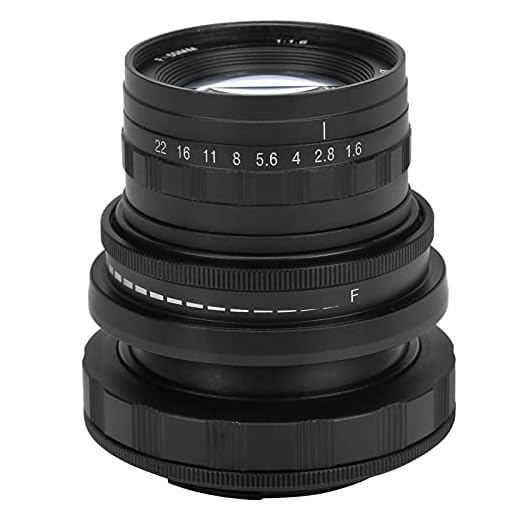



When selecting a glass for photography, consider the needs of your shooting style. A standard 50mm f/1.8 prime is often recommended for its versatility and sharpness across various conditions. For those who prefer landscapes, a wide-angle lens with a focal length of 16-35mm provides stunning depth and perspective.
If you find yourself captivated by wildlife or distant subjects, telephoto lenses ranging from 70-200mm or even 150-600mm can deliver sharp images while maintaining a significant distance from the subject. Macro options, around 90mm, allow for breathtaking close-ups, revealing incredible detail in small subjects.
Zoom lenses such as 24-70mm offer flexibility, allowing a range of compositions in a single package. For creative shots, fisheye lenses with their unique distortion can add an artistic flair and accentuate your subject. Each type has distinct characteristics that cater to specific genres, so understanding these choices will enhance your photography.
Lens Variants for Enhanced Photography
Choosing the right optical accessory can significantly influence your photography. Here’s a breakdown of key types you might consider:
- Prime: Fixed focal length, typically offering superior image quality and larger apertures. Ideal for portraits and low-light situations.
- Zoom: Variable focal length allows flexibility in framing shots without changing lenses. Perfect for dynamic environments.
- Wide-Angle: Provides a broader view, ideal for capturing architecture or expansive scenes. Usually features a shorter focal length.
- Telephoto: These lenses excel at bringing distant subjects close, making them perfect for wildlife or sports photography.
- Macro: Designed for extreme close-ups, useful for photographing small details like insects or flowers.
- Fish-eye: Creates a spherical, distorted perspective, offering creative opportunities in unique compositions.
When selecting a suitable accessory, consider the subject matter, lighting conditions, and desired effects. Each category serves distinct purposes and can enhance your creative expression.
Experimenting with various types will reveal the best fit for your photographic style. Prioritize versatility and quality based on your specific needs.
Understanding Prime Lenses and Their Advantages
For a photographer seeking sharpness and quality, prime lenses are a wise choice. These fixed focal length lenses often outperform zooms in terms of image clarity and low-light capability.
Key Benefits
The simplicity of construction in prime lenses leads to fewer optical elements, which enhances light transmission. This results in significantly brighter images, allowing for lower ISO settings and faster shutter speeds, crucial for capturing sharp images in dim environments.
Another advantage lies in their compact size. Prime lenses generally weigh less and take up less space in a bag, making them ideal for travel and street photography. Their lightweight nature can significantly decrease fatigue during extended shooting sessions.
Creative Control
Fixed focal lengths encourage photographers to experiment with composition. By physically moving closer or further away from the subject, I become more engaged in the creative process. This interaction often leads to unique perspectives that might be overlooked with zoom lenses.
Moreover, many prime lenses possess wider maximum apertures, enabling striking background blur and isolation of the subject. This characteristic is especially valued in portrait photography, where subject emphasis is paramount.
When considering lens choices, establishing a prime lens in your kit enhances both technical quality and artistic value in your imagery.
Exploring Zoom Lenses: Versatility vs. Quality
In choosing zoom optical systems, I prioritize flexibility over fixed focal lengths. They allow me to cover a range of scenes without changing gear. This adaptability is particularly beneficial in dynamic environments like weddings or wildlife photography.
However, the trade-off often lies in optical quality. Zooms typically have more elements, which may lead to issues such as distortion at certain focal lengths or reduced sharpness. I find it essential to research specific models known for maintaining image quality throughout their zoom range.
For instance, high-end zoom glass can rival fixed focal systems in sharpness and bokeh, making them suitable for professional work. Constant aperture models offer consistent exposure settings across the zoom range, enhancing usability in varying lighting conditions.
In my experience, lightweight zoom lenses provide convenience for travel. Yet, for controlled environments or portraits, prime lenses still have the edge in rendering quality. Balancing these considerations is key; I often carry both types to cover all my shooting requirements.
Macro Lenses: Capturing Details in Close-Up Photography
For anyone passionate about capturing intricate details, macro optics offer unparalleled precision and clarity. These specialized glassware pieces enable me to photograph subjects at extremely close distances, revealing textures and patterns often unseen by the naked eye.
Focusing on Close Range
A key characteristic that defines macro optics is their ability to focus at short distances–typically within a ratio of 1:1, which means life-size representation on the sensor. This feature allows me to get exceptionally close to the subject without losing sharpness.
Lighting and Depth of Field
Controlling light is crucial in macro photography. I often use ring lights or dedicated macro flash units to illuminate subjects from all angles, preventing harsh shadows. The shallow depth of field commonly seen in close-ups can create stunning bokeh effects, emphasizing the main subject while blurring the background. Experimenting with aperture settings gives me control over focus, allowing certain parts of the image to draw attention over others.
Choosing a macro lens can depend on factors such as focal length, image stabilization, and compatibility with existing camera gear. A 100mm macro lens is often preferred for its versatility, providing sufficient working distance to avoid disturbing delicate subjects like insects or flowers. Ultimately, investing in macro optics enriches my photographic journey, unveiling a fascinating world of detail.
Wide-Angle Lenses for Architecture and Scenic Shots
For capturing expansive views of architecture and nature, a wide-angle lens is indispensable. My recommendation is to opt for focal lengths ranging from 10mm to 24mm for the best results. Such lenses allow you to embrace vast spaces without sacrificing detail.
Benefits of Wide-Angle Lenses
These optics excel in specific scenarios:
- Ability to include more elements in a frame, ideal for tight spaces.
- Enhanced perspective, providing a sense of grandeur and depth.
- Reduced distortion at the edges, especially in higher-quality models.
Choosing the Right Model
When selecting a wide-angle piece, here’s what to consider:
| Feature | Details |
|---|---|
| Maximum Aperture | Apertures of f/2.8 or wider are preferable for low light. |
| Lens Construction | Look for multi-coated glass to minimize flare and improve contrast. |
| Focus Type | Auto-focus is often faster, but manual focus allows for precise control. |
Wide-angle lenses can be an excellent investment for photographers aiming to capture expansive scenes effectively. Experiment with various angles and compositions to maximize the potential of these tools.
Telephoto Lenses: Ideal for Wildlife and Sports Photography
For anyone serious about capturing stunning wildlife or dynamic sports action, investing in a telephoto lens is paramount. These specialized optics allow you to photograph subjects from a considerable distance without compromising on detail. A focal length of 200mm or longer provides the reach needed to isolate subjects in expansive environments, making them perfect for nature and sporting events.
Types and Specifications
Choosing a telephoto lens can depend on budget and specific requirements. Prime versions often offer superior image quality and wider apertures, which are advantageous in lower light. However, zoom models provide flexibility, allowing you to adjust framing quickly without moving closer. Popular choices include:
- 200mm f/2.8: Excellent for portrait-focused sports photography, where subject isolation is key.
- 300mm f/4: Lightweight and sharp, ideal for birdwatching or wildlife where subjects may be skittish.
- 70-200mm f/2.8: A versatile zoom, widely favored for capturing both tightly framed sports moments and candid wildlife snaps.
Techniques for Best Results
Utilizing a telephoto lens effectively involves understanding depth of field and motion. A wider aperture helps create a pleasing background blur, emphasizing your subject. Additionally, a steady hand is crucial; using a tripod or monopod can enhance sharpness, especially at longer focal lengths. For fast-moving subjects, continuous focus modes and high-speed burst shooting can significantly increase your chances of capturing that perfect moment.
By selecting the right telephoto lens and applying these techniques, photography enthusiasts can elevate their wildlife and sports images, ensuring clarity and impact in every shot.
Specialty Lenses: Fisheye and Tilt-Shift Explained
Considering unique visual effects? Fisheye and tilt-shift optics provide captivating options for photographers seeking to expand their creative toolkit.
Fisheye Lenses
Fisheye optics are ultra-wide-angle lenses that generate a distinctive, circular image by creating extreme barrel distortion. This type enhances perspective, making it ideal for capturing expansive scenes, artistic compositions, or immersive storytelling. Typically, these lenses come in two formats: full-frame, which covers a 180-degree field of view, and circular, which creates a circular image within the frame.
For action and adventure shots, such as skateboarding or surfing, fisheyes can amplify the dynamic nature of the scene. I often use these lenses to make ordinary locations seem surreal and otherworldly, especially in urban photography or imaginative portraiture.
Tilt-Shift Lenses
Tilt-shift optics are designed for controlling perspective and depth of field, allowing for unique adjustments in composition. Tilting the lens alters the plane of focus, which can create miniature-like scenes, while shifting enables correction of perspective distortion in architectural photography. This versatility is perfect for capturing sweeping vistas or maintaining straight lines in images of tall buildings.
In my experience, tilt-shift lenses are indispensable for commercial photography or any work involving architecture. The ability to manipulate focus planes adds depth and dimension, enhancing the overall visual impact. Mastering the application of these lenses can transform ordinary shots into extraordinary pieces of art.
Both fisheye and tilt-shift lenses present opportunities for unique imagery that strays far beyond conventional photography. Experimentation with these specialized tools can yield fascinating results and stimulate innovative thinking in capturing the world around us.
Choosing the Right Lens for Your Camera System
Selecting a compatible optical attachment is critical for maximizing your photography potential. Here are some tailored suggestions for various shooting situations:
Assess Your Needs
- Consider the subject matter: Portraits, landscapes, sports, or macro photography demand different optics.
- Evaluate your shooting style: Do you need speed, low light capabilities, or versatility?
Compatibility with Camera Body
- Match the lens mount type to your camera system; check brand specifications.
- Factor in crop factor if using an APS-C camera with full-frame optics.
Before committing to a purchase, testing options in-store or renting can provide insights into how they perform in real scenarios. Factor in weight and size–heavy lenses can be cumbersome while traveling.
I recommend examining reviews and sample images to assess sharpness and bokeh effects, especially if aesthetics are a priority. This can guide you in determining which optical attachment suits your creative vision best.
Budget Planning
- Investing in quality can lead to superior results; be aware of your financial limits.
- Consider investing in prime lenses for budget-friendly sharpness–often, they outperform zooms at similar price points.
Exploring refurbished or third-party lenses may also yield greater savings while expanding your options. Prioritize features that align with your photography goals, and don’t hesitate to seek advice from fellow shooters to gain more perspective.











